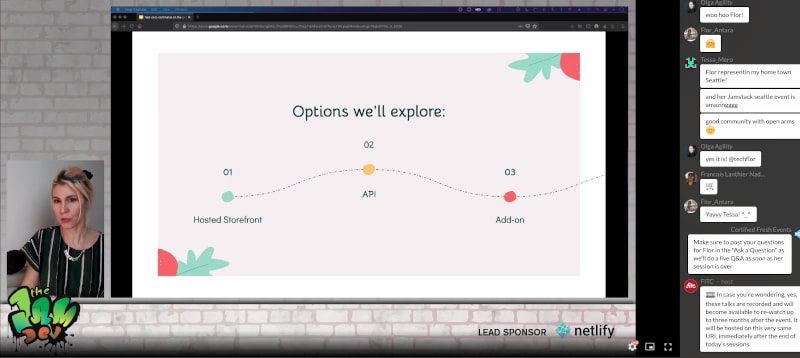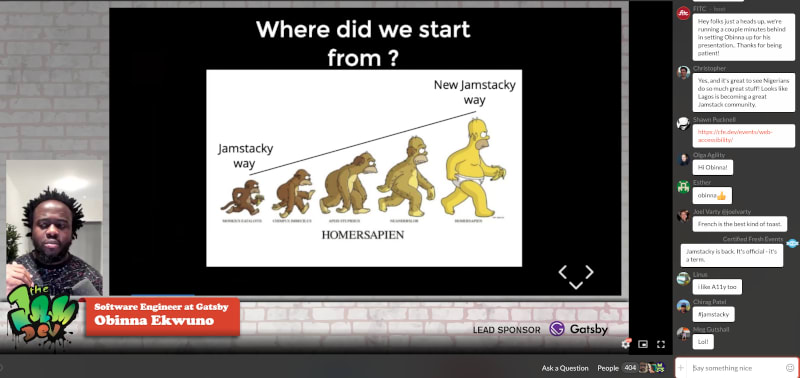It can sometimes appear from the outside that running a virtual conference is easy. Just hook up Zoom to a streaming service and you're done. About a month ago, I ran my first virtual conference. Suffice it to say that this isn't the case, even with four years of experience running virtual meetups and trainings via cfe.dev.
I wasn't alone (thank God!) as I partnered with FITC to help but, as many folks are looking to run one, I thought I's share some thoughts based upon my experience.
The Details
Every event is different, so my advice may have limited mileage if you are running a very different type of event. So, let me start by setting some of the parameters of how we chose to run this event.
- This was a paid event. The cost was far less than an equivalent in-person event ($79 at full price) but it wasn't free. Registered attendees got access to the live event as well as exclusive access to the recordings for a period of 3 months after. We'll discuss this model in a moment.
- The event was broadcast via Crowdcast using a paid account that allowed up to 5 hours for a single session.
- The streaming used a combination of Zoom and Skype. I don't know the technical details as the video person from FITC handled it.
Get Help to Get the Production Quality Right
This was critical. My original plan was to run this all by myself, but it turns out that there is a lot to manage. It can be done, but if you plan to charge or have sponsors or both as we were, you'll really need to enure that the quality is high. This will make your sponsors happy, your attendees happy and your speakers happy.
However, there's just a lot to manage for a single individual and it wasn't all just on the day of the event. Here are some things to consider:
- You'll want to meet with every speaker beforehand to test the techical setup. Be sure to test audio and video quality as well as screen sharing. For some speakers who don't have a reliable connection, pre-recording the talk may be preferable. Also share with speakers what to expect on the day of.
- You'll likely want to create high quality graphics to use during the event. We had a frame that would change to include speaker info, sponsor info and more.
- You'll want to create a detailed timeline for the event detailing exactly when things should occur, down to the minute. This ended up being a huge help to keep everything on time and to align live streams with recorded video and more.
- The day of the event, you'll have a lot to handle. We had someone handling speaker intake (in our case this was done via Zoom). Someone handling the stream, ensuring the right video and audio was being broadcast and keeping everything on schedule. Someone manning the Q&A and chat. Someone as emcee (me, in our case) and managing the live Q&A (if you have one, which, as you'll see later, you should). Keep in mind that you may also have people dealing with technical issues connecting or other logistical questions from attendees that come in via email, Twitter or elsewhere. Having someone to handle that as well was very helpful.
The point is that, even though this is virtual, it is a lot. You'll likely need some help. It's worth assigning resonsibilities beforehand as well.
Think About Your Business Model
The economics of independent virtual events can be difficult. First, so many companies are running free events that it can make paid events a difficult sell. Plus, let's be honest, a virtual event doesn't feel as valuable as an in-person event. This is partly because it can be diffucult for attendees to get away from work or personal responsibilities for a virtual event.
As mentioned before, we went with a paid ticket for all attendees as well as sponsorships, of course. The full price ticket started at $79 for 2 days of event. While nowhere near as expensive as an in-person event, it's still tough to compete against free. Obviously, the up-front costs of a virtual event are much, much lower than an in-person one. The lack of food, venue and travel costs makes the risk much lower, but there are still quite a few costs - especially if you take my advice and get some professional A/V and production help.
Looking back, I might consider moving to a free to attend live/pay for recording access model that many other conference organizers seem to be moving to. We did fine on attendees but this model may have brought many more, which makes sponsors and speakers happy. We might have given up money on the ticket sales, but the larger attendee base could make sponsorships more valuable. Perhaps it would have been the same financially, but more attendees is always better for a virtual event, where capacity is generally not an issue.
Take Advantage of Being Virtual
One of the hardest things to do is to think about the event in ways that don't just try to replicate an IRL event virtually. This is important because, in my opinion, simply trying to replicate an IRL virtually simply highlights the areas that virtual events are weakest rather than where they offer some unique opportunities. I won't say we got this right, but I do think some things worked better than others.
Live vs. Recorded Sessions
We had a mix of recorded and live sessions. For a full session speaker, they had the option to record or present live. I think about half the speakers chose to record. However, every full session included a 15 minute live Q&A after. All questions during the session were held for this Q&A period.
I don't feel that there was necessarily anything lost by recording the sessions. It actually can remove the potential for technical issues. However, the live Q&A was really critical. It allowed attendees to interact with the speakers in a way that often doesn't happen at IRL events (or happens awkwardly). The questions were all asked by the emcee, but there was a lot of back and forth via the chat and attendees seemed the most engaged during this period.
Mix Up the Format
Sitting in front of a screen all day for a virtual event can be slightly tedious. You can fight this somewhat by changing up the session format throughout the day in ways that aren't always as easy for an IRL event.
We had three types of sessions: standard sessions that were 30 minutes with 15 minute live Q&A; 10 minute lightning talks that had no live Q&A; and fireside chats that were approximately 40 minutes. I felt that changing up the format kept the event from feeling tedious or stale. The lightning talks, in particular, were a lot of fun, kept things moving quickly and worked well for a change of pace. Lightning talk speakers did not have live Q&A but were asked to participate in the chat during their talk, which kept the chat lively during these as well.
Fireside Chats Can Work
I will admit that I was skeptical of having the two keynotes as fireside chats. I worried that it wouldn't offer as much value as a traditional session. I have changed my mind after the event. The fireside chats offered a unique opportunity for attendees to interact with the keynote speakers in a way that would be very difficult at an IRL event. We had some questions that I prepared as emcee to get the conversation rolling but encouraged questions from the audience. We ended up with a ton of audience participation for both of our fireside chat keynotes and attendees seemed to really enjoy the unique opportunity to interact with the speakers that this gave them. Honestly, these were my favorite parts of the event.
Virtual Events Are Here to Stay
Hopefully we can get back to IRL events soon. I miss the direct interaction you get with other attendees. I usually learned as much in the hallway as in the session rooms. Still, it seems pretty clear that, even as things return to normal, virtual conferences or hybrid virtual/IRL events will continue to play a larger role than they did pre-COVID. I think this is great. It gives many people access to a conference that otherwise would not have had access due to the costs or difficulties of travel. And, we're getting better at running them and making them more fun and valuable in ways that take advantage of the benefits being virtual offers.






Top comments (0)